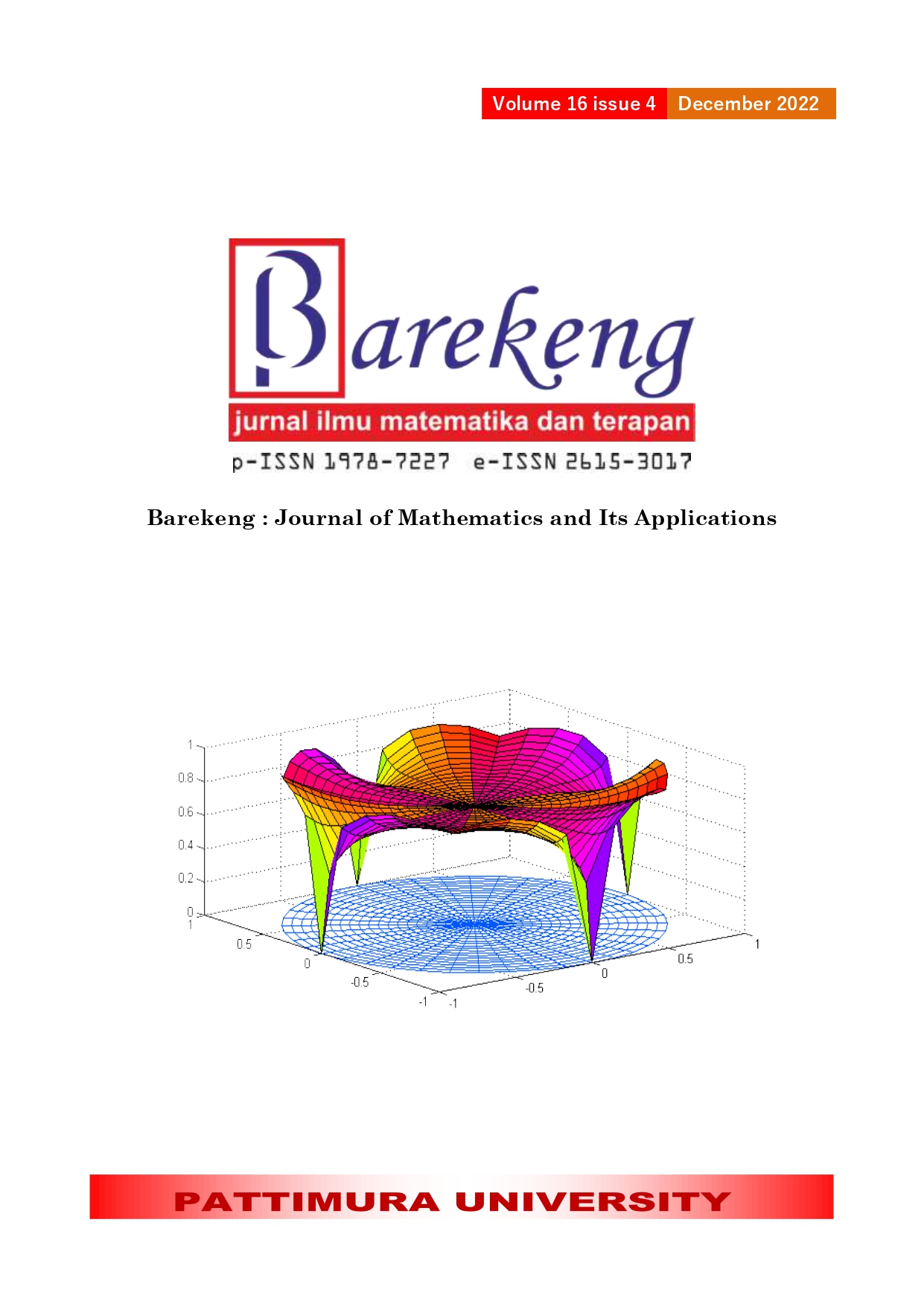A NOTE ON THE SOLUTION OF THE CHARACTERISTIC EQUATION OVER THE SYMMETRIZED MAX-PLUS ALGEBRA
Abstract
The symmetrized max-plus algebra is an extension of max-plus algebra. One of the problems in the symmetrized max-plus algebra is determining the eigenvalues of a matrix. If the determinant can be defined, the characteristic equation can be formulated as a max-plus algebraic multivariate polynomial equation system. A mathematical tool for solving the problem using operations as in conventional algebra, known as the extended linear complementary problem (ELCP), to determine the solution to the characteristic equation. In this paper, we will describe the use of ELCP in determining the solution to the characteristic equations of matrices over the symmetrized max-plus algebra.
Downloads
References
G. Ariyanti, A. Suparwanto, and B. Surodjo, “Necessary and sufficient conditions for the solution of the linear balanced systems in the symmetrized max plus algebra,” Far East J. Math. Sci., vol. 97, no. 2, pp. 253–266, 2015, doi: 10.17654/FJMSMay2015_253_266.
B. De Schutter, T. van den Boom, J. Xu, and S. S. Farahani, “Analysis and control of max-plus linear discrete-event systems: An introduction,” Discret. Event Dyn. Syst. Theory Appl., vol. 30, no. 1, pp. 25–54, 2020, doi: 10.1007/s10626-019-00294-w.
K. U. Leuven, F. D. E. R. T. Wetenschappen, and D. Elektrotechniek, Max-Algebraic System Theory for Max-Algebraic System Theory for. 1996.
K. G. Farlow, “Max-Plus Algebra,” 2009.
B. De Schutter and B. De Moor, “The Extended Linear Complementarity Problem and Its Applications in the Max-Plus Algebra,” Complement. Var. Probl. State Art, vol. 09, pp. 22–39, 1997.
K. Kondo, “Ultradiscrete sine-gordon equation over symmetrized max-plus algebra, and noncommutative discrete and ultradiscrete sine-Gordon equations,” Symmetry, Integr. Geom. Methods Appl., vol. 9, 2013, doi: 10.3842/SIGMA.2013.068.
W. Mora, A. Wasanawichit, and Y. Kemprasit, “Invertible Matrices over Idempotent Semirings,” vol. 1, no. 2, pp. 55–61, 2009.
C. Leake, F. Baccelli, G. Cohen, G. J. Olsder, and J.-P. Quadrat, “Synchronization and Linearity: An Algebra for Discrete Event Systems.,” J. Oper. Res. Soc., vol. 45, no. 1, p. 118, 1994, doi: 10.2307/2583959.
D. Singh and D. Ph, “A Note on Symmetrized Max-Plus Algebra,” vol. 5, no. 1, pp. 1–10.
M. E. Brigden, R. W. Cottle, J.-S. Pang, and R. E. Stone, The Linear Complementarity Problem., vol. 156, no. 1. 1993. doi: 10.2307/2982870.
H. Mursyidah and S. Subiono, “Eigenvalue, eigenvector, eigenmode of reducible matrix and its application,” AIP Conf. Proc., vol. 1867, no. August 2017, 2017, doi: 10.1063/1.4994447.
B. De Schutter and B. De Moor, “A note on the characteristic equation in the max-plus algebra,” Linear Algebra Appl., vol. 261, no. 1–3, pp. 237–250, 1997, doi: 10.1016/s0024-3795(96)00407-7.
S. Gaubert, P. Butkovič, and R. Cuninghame-Green, “Minimal (max,+) realization of convex sequences,” SIAM J. Control Optim., vol. 36, no. 1, pp. 137–147, 1998, doi: 10.1137/S036301299528534X.
Z. R. Königsberg, “A generalized eigenmode algorithm for reducible regulå matrices over the max-plus algebra,” 2009 Chinese Control Decis. Conf. CCDC 2009, no. 24, pp. 5598–5603, 2009, doi: 10.1109/CCDC.2009.5195195.
S. Watanabe and Y. Watanabe, “Min-Plus Algebra and Networks (Novel Development of Nonlinear Discrete Integrable Systems),” RIMS Kôkyûroku Bessatsu, vol. 47, 2014.
Copyright (c) 2022 Gregoria Ariyanti

This work is licensed under a Creative Commons Attribution-ShareAlike 4.0 International License.
Authors who publish with this Journal agree to the following terms:
- Author retain copyright and grant the journal right of first publication with the work simultaneously licensed under a creative commons attribution license that allow others to share the work within an acknowledgement of the work’s authorship and initial publication of this journal.
- Authors are able to enter into separate, additional contractual arrangement for the non-exclusive distribution of the journal’s published version of the work (e.g. acknowledgement of its initial publication in this journal).
- Authors are permitted and encouraged to post their work online (e.g. in institutional repositories or on their websites) prior to and during the submission process, as it can lead to productive exchanges, as well as earlier and greater citation of published works.






1.gif)



